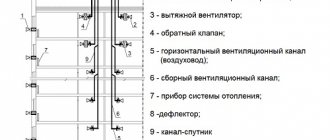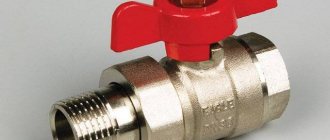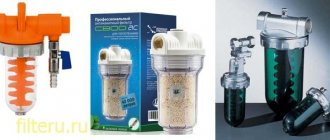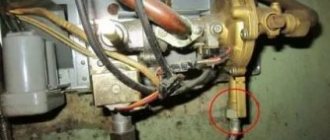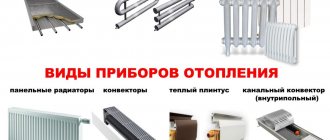Do you think that heat bills are too high and the quality of service is unsatisfactory? Don't want to depend on planned and unscheduled outages? Tired of sudden temperature changes in batteries that do not correspond to weather changes? You have a completely legitimate opportunity to solve all these problems at once by installing your own heating boiler and disconnecting from the central heating network. But before you go to a plumbing store, you need to get as much information as possible about how to do everything correctly and in accordance with building codes. Do you want to properly arrange autonomous heating in your apartment? Then get some basic information about this case here.
Autonomous heating in the apartment
Heating devices: replacement procedure
Replacing a battery requires knowledge of the law and your own civil rights.
Where should I contact?
In the event of an accident, you must urgently notify the housing office, informing about the fact of the breakthrough. If it happened at night, then call the 24-hour emergency service number.
It is advisable to record, either on video or in photos, the fact of flooding, as well as the state in which the apartment has become. The housing office does not like to make payments for repair costs, trying to prove that the owner is at fault.
In the event of an accident, the owner decides who to invite for repairs: specialists from the housing office or private owners. The price tag for these specialists is approximately the same. Here is a comparison table:
| Need for action | Housing and communal services office | Private office |
| The need to coordinate actions | There is no need for approval, since the work will be carried out after:
| Must be agreed with the management company |
| Guarantee of services provided | Checking the quality of the work performed is possible only at the start of the heating season. It’s easier for housing and communal services employees, because they are the ones who run the system. | The guarantee is given upon concluding an agreement for the provision of services. But private owners do not respond to complaints. Then you have to file a lawsuit. |
Sample applications
There are two types of applications you can submit:
- With a request to change the radiator.
- With a request to turn off the riser and water drainage. An application for replacing heating batteries in an apartment is required in order to obtain permission and agree on the time of work, and the second application is required for the purpose of carrying out the necessary work.
These statements do not have a regulated form of preparation, therefore they are written in an arbitrary manner, signed by the applicant, namely:
- in the upper right corner you must indicate: information about the official, the name and legal address of the management company. Then indicate the applicant’s name (full name, address, contacts);
- Write the name of the document in the center of the sheet: “Application”. Below is a detailed description of the problem. It is useful to refer to legal norms/government regulations;
- It is useful to attach a photo/video as evidence. To do this, under the text of the application, you need to write the word: “Appendix”, then list all the attached materials;
- You must indicate the date below and sign it.

The application must be accompanied by:
- document of ownership of housing;
- the applicant's identity card with a copy;
- apartment plan with layout and designation of the heating system.
The Housing Office secretary is obliged to accept the papers, assigning them a registration number. The application is considered for a month from the date of its submission. The housing office must inform the applicant in writing about the results of the review.
Price
The cost of replacing heating appliances through the housing office depends on the region: in the capital the price will be much more expensive than in the provinces. Here is the average price range for battery replacement:
- turning off water in risers - from 500 to 1,700 rubles;
- price for replacing a radiator (excluding the price of batteries) – from 4,000 to 6,000 rubles;
- emergency radiator (which is leaking, if there is a conclusion about it) - replaced free of charge by submitting an application to the management company;
- for one battery the plumber will ask from 3,000 to 6,000 rubles. This includes: pipe replacement, welding, installation.
Installation of taps and thermal heads
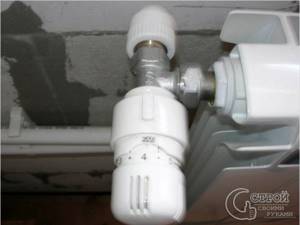
Installed thermal head
Having decided how to connect the radiator, think about installing taps. The tap is installed at the inlet and outlet. In most cases, they will be useful in the event of an accident; moreover, they can regulate the level of heat transfer. If you are using a single-pipe system, then using taps you can adjust the temperature of all radiators evenly. Thermal heads that turn off the coolant supply when the set air temperature is reached can be of great benefit. However, you won’t see a temperature scale on it; the maximum is notches or numbers. Through experimentation, you can adjust the thermal head to the desired temperature.
Their particular benefit is felt in those areas or rooms where there is a risk of overheating. How to explain this? For example, you heat your two-story house using a two-pipe system. In this case, the coolant first warms up the radiator installed in a small dressing room on the second floor, and only then drops down to the first in the large room. Accordingly, until the temperature on the first floor reaches the required level, there will be “Tashkent” on the second floor. However, if thermal heads are installed there, then overheating of a particular room is prevented. The heat will be redirected to a colder room, and for a certain time the same temperature will remain stable there.
Now that the boiler, batteries are installed, and thermal heads and bypasses are installed, you can begin installing the pipes. However, first we will consider which pipes are best to choose, and then we will talk about the technology for their installation.
How to choose a material for connecting a radiator
As we said earlier, different types of materials are currently used to replace radiators. Before replacing heating radiators, you need to decide which connection option will be used - welding, polypropylene or metal-plastic pipes.
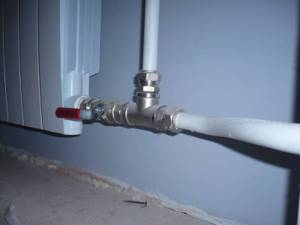
Connecting batteries with metal-plastic pipes
Almost 95% of all radiator connections in apartments in our country are made through metal-plastic pipelines. Welding or polypropylene are not so popular due to the fact that metal-plastic is distinguished by its reliability, durability and high level of tightness. In addition, this option looks very neat and beautiful and fits well into the interior of the apartment.
System testing is the key to reliable operation
For personal safety and high-quality operation of the heating system with updated radiators in the apartment, it is necessary to test the equipment after completing all installation work. To do this, you should agree with those people who drained the water from the system, so that after completion of the work they will immediately release it under pressure.
However, it is important to remember that in most cases, the heating system is completely filled only during general start-up, when the pressure reaches 2-4 atm. If any defects are discovered during the tests, they must be eliminated as soon as possible.
Selection of boiler power for autonomous heating
During the preparation of the project and permission to install autonomous heating, it is necessary to determine what power boiler will be sufficient to heat your apartment. To do this, perform a simple calculation using the following formula:
Q=S*P*K1*K2*K3*K4*K5*K6*K7*R
The result of the calculations is Q - power sufficient to heat the apartment; watts are used as units of measurement. For variable S, select the total area of the apartment. P is the average amount of power sufficient to heat one square meter of a living room. In this case it is equal to 100 W/m2. Variables K1-K7 hide multipliers, whose value depends on certain factors that can affect the efficiency of the heating system. You can see their values in the table. You can read about the program for calculating the power of a heating boiler in our article.
Table. Correction factors for calculating the power of a heating boiler.
Attention: The internal data of table “138” is corrupted!
Having multiplied the area of the apartment, the value of the average power and the correction factors, it remains to include the last variable in the formula - R. It denotes the reservation of heating boiler power and has a value from 1.15 to 1.25.

In addition to the boiler power, it is advisable to calculate the power of the radiators if you replace them in your apartment. Then, based on this figure, you can select the required number of sections for your batteries

Average temperature in January depending on climate zone. You should focus on these indicators when choosing a boiler for your apartment - the colder the winter, the more powerful the device should be. Do not forget also that the boiler must have some reserve, designed to heat your home in the event of extremely severe frosts
Which radiator is better?
Among all the radiators that are sold in the store, choose the one that you would like to see in your room. It should fit into the interior, perhaps even be its exclusive part. Next, consider its characteristics.
The choice of radiators can be based on the following indicators:
- where are you going to install;
- radiator type;
- material;
- power;
- operating pressure;
- sectional or monolithic panel;
- exotic appearance;
- price.
You can choose such a radiator to suit your interior
Cast iron radiators last a long time, but they are heavy, initially require overhaul and replacement of gaskets, take a long time to heat up and have poor heat transfer. They cost not much less than bimetallic ones.
Bimetallic and aluminum radiators make no difference from a practical point of view. The operating pressure, even in high-rise buildings, does not exceed 10-12 atm and such radiators can easily withstand it. Look in the passport - the manufacturer indicates the working pressure and testing pressure, which is not less than 15 atm. This applies to houses with a riser system.
Coolant circulation. Scheme selection
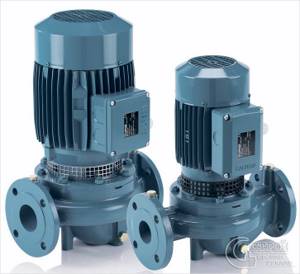
Circulation pump
Before starting installation work, it is necessary to decide on the choice of water circulation scheme. There are three types:
- Forced.
- Natural.
- Combined.
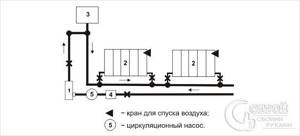
Forced
The forced coolant circulation system is carried out by means of a circulation pump. Moreover, their number can be unlimited: one, two or three. Using such a water heating system, you can increase the efficiency by 30%. Using a circulation pump will allow you not to maintain a certain slope of the pipes when laying them. But on the other hand, the system will be completely dependent on electricity. It should be remembered that it must be a closed type with an operating pressure of 1.5 bar.
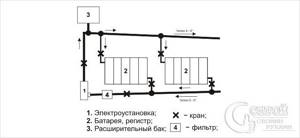
Natural
As for natural circulation , it has been fully tested and is a reliable method of heating a home. In this case, the slope of the pipe during installation is strictly observed, within 3-5°. If this is ignored, the water heating system will be ineffective, or rather, it will not work at all. Most often it is used for systems with solid fuel boilers, although there are options with gas boilers.
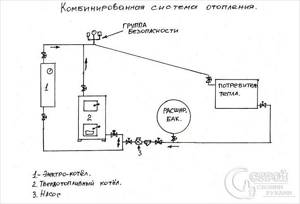
Combined
Well, the combined circulation system (CCS) implies the ability to operate a water heating system both forced and natural. For example, if the power goes out during the heating season, the system can be switched to natural circulation. For this reason, despite the possibility of installing pumps, the installation of pipes must be carried out at an angle. In most cases, a combined heating scheme is used in combination with solid fuel boilers.
Heating radiators and their calculation
Many people know in general terms how heating works in an apartment building. Very often you see cast iron batteries in apartments connected to a centralized system. Such radiators are not suitable for autonomous heating in an apartment. They have too large a capacity, so you have to heat a lot of water. And besides, cast iron also takes a long time to warm up. Therefore, when using cast iron batteries, there will be excessive gas consumption, and as a result, large financial costs.
When making heating repairs in an apartment, you should pay attention to radiators made of other materials. Experts recommend installing modern batteries made of steel, aluminum or bimetal (read: “How to install heating radiators in an apartment - a quick guide”)
All of them are suitable for low pressure heating systems (this is typical for small water circuits) and can also withstand high temperatures. If necessary, you can even combine radiators and a “warm floor” system in one circuit. As for how to improve heating in an apartment, it is recommended to install aluminum radiators. But they are quite difficult to operate (read: “Heating in an apartment: diagrams and features of the project”). If the content of alkalis in the water is high, it is necessary to add neutralizers to the system. It is also unacceptable for copper to enter the circuit, since the interaction of this metal with aluminum leads to their oxidation and, accordingly, destruction. In addition, aluminum radiators are not affordable for everyone.
Before purchasing radiators, you need to calculate the required power and number of sections
If the question arises about how to make the apartment warm, then this stage should be given special attention
To calculate the number of sections in a radiator, you can use the formula Sх100/P if the ceiling height is no more than 3 meters. The area of the room is designated by the letter S, and the rated power of one section is P. Typically, the power of a section is 180-200 W. The number 100 is the required number of watts per square meter of area. The result is denoted, for example, by the letter K.
If a do-it-yourself apartment heating system involves the use of panel radiators that are not divided into sections, then a different formula is used for calculations. In this case, you will have to calculate the power and size of the batteries. The formula looks like this: P=Vx41. The initial power is denoted by the letter P, the volume of the room is V. The number 41 is the number of Watts required to heat one “square” of area.
For example calculations, you can take a room with a height of 2.7 meters and an area of 15 “squares”. This means V=2.7x15=40.5. Now it’s time to calculate the power of the radiator. The resulting formula is as follows: P=Vx41=40.5x41=1660.5. Since there are no heating devices of such power, it is worth choosing a radiator with an indicator of 1.5 kW.
After completing the calculations, you can buy radiators. Heating distribution in the apartment should occur according to a well-designed scheme.
How to make heating yourself, detailed video:
Scenario for the first case
In harsh climates, no source of heat generation other than mains gas provides significant advantages over centralized heat supply.
Of course, heating with coal or wood can be close to gas heating in terms of efficiency, but since we are talking about an apartment, and not a private household with outbuildings, there is no place to store solid fuel reserves, and the interfloor ceilings are not designed for such heavy loads.
If you use bottled gas as a source of thermal energy, then using replaceable cylinders is extremely inconvenient. The use of this type of fuel will increase financial costs several times compared to mainline supplies.
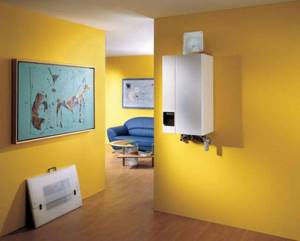
Naturally, every owner will not give up central heating if without it he will have to pay more money. Installing gas heating in an apartment is beneficial not only from the economic side. The fact is that modern heating equipment used for this can function autonomously without constant control by the owner.
The best choice for a small apartment would be a gas double-circuit unit complete with electronic ignition and a programmable remote thermostat. The presence of these devices ensures optimal temperature conditions in the rooms automatically.
If there is sufficient space in the apartment, it is advisable to give preference to a heating device with a storage boiler, which will provide a stable temperature of hot water.
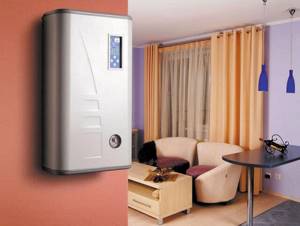
But gas heating in an apartment is not an absolutely ideal option, because:
- Despite the fact that gas-powered equipment is considered relatively safe, leaks still occur from time to time, leading to an explosion.
- When gaseous fuel burns, greasy soot is formed, which gradually clogs the ventilation ducts, which serve to remove combustion products. If they are discharged through a coaxial chimney onto the facade of the building, then with the windows open, residents will have to breathe polluted air.
- If you use a gas boiler, the ventilation system in the room where it is installed must meet certain requirements. An exception is made only for the removal of combustion products into the atmosphere through the wall of the house, but permission is required to remove the pipe through the facade.
- The price of gas has a constant upward trend, which makes autonomous gas heating in an apartment uneconomical.
And how to do it
But leaving aside for now the questions of who should do what and be responsible for what, let’s consider purely technically how it is possible, for example, to replace old pipes with plastic ones. This will allow you to remove worn-out pipes clogged with deposits, installing new ones, and thus help solve the problem of how to increase the heat transfer of a heating pipe - due to the passage of more coolant.
In this case, what your neighbors have will be critical for completing the work. If the neighbors above have already replaced the metal riser pipe with a polypropylene one, then you should install the same one.
It is best if you can agree with them on the possibility of connecting to their junction. In this case, you are dismantling the heating in the apartment, i.e. cut out all the old pipes, cut out an adapter from plastic to metal from a neighbor, determine locally the required length of pipes that need to be laid. Then the metal scrap is pulled out from the ceiling, a propylene pipe is inserted in its place and soldered through a propylene coupling to the neighbor’s pipe.
Connecting a metal and polypropylene pipe using a special coupling
In cases where your neighbors have metal left and they do not allow you to make a joint at their place in order to go through the ceiling, you will have to cut your pipe under the ceiling and cut a thread on its remains. A transition coupling for polypropylene is placed on it, and the corresponding pipe is already connected to it.
If you want the heating replacement in the apartment to be complete, i.e. If you are planning to replace radiators, then you need to start work with them.
There are quite a lot of them, and of very different types, but regardless of this, there are general rules, the implementation of which will allow you to get a good result:
- all radiators in the apartment must be placed equally, on the same level;
- the battery must be positioned strictly vertically;
- its top should be five cm below the window sill and six cm above the floor;
- when attaching a radiator, there should be one mounting bracket per square meter of its surface;
- the front surface of the battery should protrude beyond the edge of the window sill.
Correct installation of a heating radiator
Tips for care and use
Finally, I would like to give you, dear readers, some recommendations for caring for the electric heaters discussed in this material. It is very important to clean the devices from dust from time to time, because it reduces heat transfer and increases electricity consumption. The IR heater and oil radiator can be wiped periodically with a damp cloth. Caring for a fan heater is somewhat more complicated - you will have to disassemble it and blow it out with a vacuum cleaner or compressor.
Important: you cannot vacuum the fan heater in normal mode - the wires will be pulled inside and they will be damaged. The device must be purged from the inside. Some modern vacuum cleaner models are equipped with this function.
Do not forget to inspect the wiring and insulation, checking its integrity. Remember that exposed wires can cause electric shock and fire.
As you can see, assembling and connecting electric heaters with your own hands is not so difficult. Of course, working with wiring requires a certain amount of experience from the master, and also does not tolerate haste and negligence. However, the game is worth the candle - by taking the time to assemble a homemade heater, you will receive an effective and economical device created from improvised materials. With proper and careful operation, a self-assembled electric heater will work without failures and will be able to provide you with warmth for many years.
Legal basis for replacing heating devices
The heating system of an apartment building is a complex mechanism that requires special settings at the beginning of each heating period and periodic adjustments during heat supply. Equipment and pipelines are common property of the house; they are on the balance sheet and in the area of responsibility of the management company or housing office of a multi-storey building.
The management company (hereinafter referred to as the management company) bears administrative and financial responsibility for maintaining the general house heating system in a technologically sound condition. This allows the management company to perform one of its main functions - providing utility services to supply residents of an apartment building with heat in full during the entire heating season.
Unauthorized interference with the operation of the system, dismantling - installation of heating radiators in the apartment - is unacceptable. This directly concerns those who live in multi-storey buildings with a riser coolant supply system.
Changing the general house heating system will affect the supply of heat to all apartments connected to the riser. Unauthorized interference is legally defined as a gross violation and entails administrative and financial liability.
The Criminal Code has the right to force the tenant to restore the changes made and impose an administrative fine. Affected neighbors have the right to sue for costs incurred, especially when the heating shutdown caused harm to their health.
The issue can be resolved if you follow the rules for installing heating radiators in an apartment and do it legally. To do this, a user who decides to make changes to the heating circuit must sequentially go through several steps before obtaining permission. Visit the control service of the management company, write an application asking them to send a commission to decide on the possibility of replacing heating devices, changing the connection diagram, and installing additional radiators.
The application is written in any form addressed to the head of the Criminal Code. The manager of the management company is obliged to accept the application, register it under the incoming number indicating the date of receipt, and put a stamp. Keep an eye on this. The Criminal Code is given 5 days to consider the application and make a decision.
If the decision is positive, the commission draws up a diagram of the arrangement of devices and piping, determines their number and permissible type, makes a hydraulic calculation, and determines the timing of the work. The project or scheme is approved by the management company, an energy saving organization. After completion of the work, the system is pressure tested, connected to central heating, and an acceptance certificate is drawn up.
The process is lengthy, requiring material and moral costs. The result will be an official permit for dismantling - installation of heating radiators in the apartment with the possibility of changing the connection diagram, installing additional devices. It is recommended to carry out work in the summer months, before the onset of the heating season.
For residents of apartment buildings with floor-to-floor zoning of central heating, such problems do not arise. The apartment-by-apartment wiring system provided for by the project allows any changes to the circuit without the approval of the management company, even installing heated floors and connecting them to central heating.
Choice of energy carrier
In multi-storey residential buildings this choice is small; only natural gas and electricity are at your service. If you already had a gas water heater, then replacing it with a boiler will be somewhat easier, although you cannot do it without agreement with the gas supply office. It will be more difficult to introduce gas heating from scratch, this is due to the registration procedure, chimney inspection reports, and so on.
Often there is no alternative to natural gas as an energy carrier for an apartment, since individual electric heating is not available due to a limited power consumption limit. Another reason to avoid electric heaters is if you live in older homes with shabby wiring. Let’s say you replace it within the apartment, but what next? However, the electrical network maintenance company will not give permission under such circumstances.
If the listed restrictions do not exist, we choose the energy carrier for economic reasons. Much depends on the cost of gas and electricity in different countries. For example, the owner of an apartment with individual heating from electricity in the Russian Federation will pay more than for gas, in Ukraine - depending on the electricity tariff, and so on.
Installation of gas-powered equipment will definitely cost more than electric equipment.
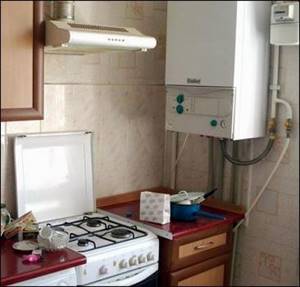
Replacing heating radiators in an apartment
Art. 25 Housing Code of the Russian Federation, Russian Federation No. 37 dated 08/04/1998, Central heating radiators
Consequently, moving or replacing heating devices, as well as changing their configuration, does not require changes in the technical passport, and also cannot be considered as a refurbishment of the premises, and, as a result, is a violation of the procedure for using common property.
Coordination
The apartment owner first needs to agree on:
- replacing the original radiators with similar radiators;
- replacing batteries with radiators of a different type, with possible configuration changes;
- transfer of batteries.
In the first case of replacing batteries with similar radiators, it will only be enough to notify the management organization about the upcoming installation.
Subsequently, you need to seek the help of a specialist who will determine the possibility of installing new devices. The examination is paid for by the owner of the apartment.
To select and replace heating devices in your apartment, you need to understand the main stages of work, as well as possible problems that you may encounter during the work process.
Material selection
Bimetallic batteries with a steel core and aluminum fins have 4 important properties:
- high mechanical strength, thanks to the high level - 16 atmospheres - operating pressure and test pressure - up to 30 atmospheres;
- the chemical stability of the core has the ability to form a galvanic couple with copper pipelines;
- high efficiency;
- the modern look is quite presentable.
Cast iron radiators are corrosion resistant
Steel radiators can be sectional or panel. Sectional radiators in appearance resemble cast iron batteries. Steel radiators are able to withstand a working pressure of 16 atmospheres and also have a long service life. The main disadvantage is the risk of damage due to water hammer or external mechanical impact, due to the relatively thin steel - 1.5 mm.
Aluminum radiators are lightweight, so battery installation can be done by one person. The positive qualities of radiators lie in the large number of product options that differ in functionality and form, as well as an immediate response to changes in water temperature. Disadvantages include the need for air removal and unacceptable contact of the coolant with other metals. If this rule is not followed, the radiator may be destroyed by chemical attack.
Calculating the number of sections
To calculate the required number of sections, you can use a simple algorithm: 2 sq. m. area = 1 section
In addition to the throttle or thermostatic head, it is advisable to install the following near each radiator:
- an additional valve on the second line of the supply line, which will completely cut off the radiator and allow, if necessary, to completely disconnect and dismantle the radiator;
- a valve on the jumper, which in the closed position will direct the entire flow of water in the riser through the radiator, otherwise through the bypass.
Types of batteries
When choosing batteries for arranging water heating at home, you need to know how existing types differ from each other, what pros and cons they may have, and how much they cost. The best battery option is bimetallic models. However, classic products made of steel or cast iron also have their advantages.

Batteries are also different and have their pros and cons.
If we talk about cast iron batteries, they are characterized by a high thermal potential, a long service life, the ability to withstand pressure up to 22 bar, and also a relatively low cost. The disadvantages of such equipment include its impressive weight, lack of ergonomics and presentable design, as well as instability to damage when dropped.
Steel batteries demonstrate the best strength, excellent thermal potential, low cost and efficiency. However, they are afraid of water hammer and are subject to corrosion. In turn, aluminum structures have better heat transfer and relatively low weight, but are afraid of water hammer and corrosion processes.
Two-pipe heating system, how to make:
As for bimetallic batteries, they are capable of operating under high pressure, are not damaged by water hammer, are characterized by simple installation and excellent anti-corrosion properties. The disadvantages include low heat transfer and high cost.
Whose property are heating radiators in apartments?
Heating devices - an intra-house heating system, including risers, heating elements, control and shut-off valves, collective heat energy metering devices and other equipment located on these networks - are common house property. Based on this, it is prohibited to independently replace radiators.
An appointed construction and technical examination can determine whether heating appliances belong to the common or personal property of the apartment owner. The expert considers the following questions:
- How are more than one room in the house served by heating elements located in the apartment?
- The heating elements of the intra-house heating system located in the apartment are intended to serve more than one room in a given house.
Selecting additional equipment
What else is needed, in addition to those devices and materials that we have already mentioned?
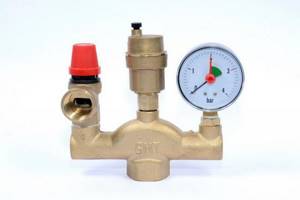
Pressure gauge 0-4 bar
- It is necessary to equip heating radiators with thermal heads and shut-off valves. The first device allows you to adjust the temperature regime of each radiator, and, accordingly, individual rooms. It is important to calibrate it correctly here. The shut-off valve will allow you to completely shut off the coolant supply if there is a need to repair the heating device or replace it.
- If the radiator is located just above the coolant filling level, it automatically becomes a collector of air from the entire heating system. Therefore, it must be equipped with a Mayevsky valve - this is an automatic air vent - or a regular valve through which you will manually bleed air from the system.
- And the last thing is the safety group, which includes an expansion tank, a safety valve, various pressure gauges, an automation system, etc. Please note that the volume of the expansion tank should be a tenth of the volume of the entire heating system.
Do-it-yourself heating from polypropylene pipes in an apartment
Residents of apartment buildings are familiar with the situation when it is necessary to replace an old cast iron pipeline. Replacing heating pipes in an apartment is a rather complicated undertaking, but even here it is quite possible to do without the help of professionals.
A self-designed new heating system in an apartment can work well if you follow the procedure and safety rules. Replacing old heating pipes in an apartment with polypropylene ones will look something like this:
- coordination of work with municipal services. The first and very important stage, which will give you permission to shut off the water supply and discharge it from the system;
- coordinating work with the residents of the apartment above and below yours. Replacing risers will be needed not only in an apartment where renovations are being carried out. However, if dismantling the riser is not possible, you can choose special adapters from cast iron pipes to plastic ones;
- dismantling old heating. Old cast iron pipes lend themselves well to dismantling, but this procedure requires compliance with some safety rules. The fragility of cast iron depends on how long the system has been in use. Old pipes break down very quickly, breaking into small pieces. When struck with a metal hammer, fragments fly off the cast iron, which can get into the pipeline: the water supply system can become clogged. Therefore, for such purposes, it is better to choose a rubber or wooden butt, which everyone probably has at home. Dismantling work should be carried out wearing a respirator and goggles;
- a diagram of the new system is formed, the radiator is hung along the specified perimeter;
- assembly of polypropylene heating pipes and connection of the radiator;
- checking the system for leaks. The testing procedure is carried out under high pressure - 1.5 times higher than normal operating pressure. If the old system was replaced with a new two-pipe system, the water should be run in the opposite direction when checking.
In apartment buildings, metal heating pipes can be replaced with polypropylene ones either completely or partially
The first step is to choose the optimal type of system. The heating system can be one-pipe or two-pipe. The number of radiators and, accordingly, the cost of work will depend on this. A two-pipe system requires a larger number of radiators: if there are more than 8 of them, then a polypropylene pipe with a diameter of 32 mm will be used for such heating. If you choose a single-pipe home heating system made of polypropylene pipes, the costs of its installation will be reduced, but the heat will not be distributed evenly. Each subsequent radiator will be cooler than the previous one. The circuit can be supplemented with thermostat valves that regulate the power of each radiator.
Whatever heating system is planned, it is necessary to place an air vent valve in the upper part of the radiator - the Mayevsky valve. In the lower parts, the holes are plugged with a stopper.
Important! When screwing the plug into the radiator inlet, use a knife blade to remove paint deposits and any other contaminants. This even applies to new radiators. Also, replacing a heating system made of polypropylene pipes with your own hands is done using fittings
clamps, couplings (plugs, angles, tees). What kind of fastening and connecting elements will require replacing pipes depends on which heating scheme was chosen. Replacement of polypropylene pipes is carried out using a welding machine. The heating time for each type of PPR pipe will be different. The most common polypropylene pipes 25 mm and 32 mm require 7-8 seconds to melt. If replacing with aluminum-reinforced PPR pipes, do not forget to pre-clean the foil before soldering
Also, replacing a heating system made of polypropylene pipes with your own hands is done using fittings. clamps, couplings (plugs, angles, tees). What kind of fastening and connecting elements will require replacing pipes depends on which heating scheme was chosen. Replacement of polypropylene pipes is carried out using a welding machine. The heating time for each type of PPR pipe will be different. The most common polypropylene pipes 25 mm and 32 mm require 7-8 seconds to melt. If you are replacing with aluminum-reinforced PPR pipes, do not forget to pre-clean the foil before soldering.
The number of pipes for heating a private house depends on the type of heating system
Coolant properties
Unfortunately, an ideal coolant does not exist, because... Each available option has its own pros and cons, as well as a number of technical parameters. If the required temperature range or pressure is not maintained, the entire system may be damaged. And repair maintenance of equipment is considered a very costly procedure, so it is better to avoid it.
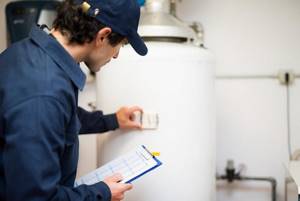
Water is a more practical heat source
As for the main parameters of the coolant that you need to pay attention to when purchasing, these include:
- Temperature regime.
- Viscosity.
- Anti-corrosion properties.
- The degree of release of toxic substances when heated.
Among the various types of coolants, water and antifreeze are in particular demand. The last option is especially relevant for country houses or premises for temporary, for example, seasonal residence. The fact is that when leaving the building, the owner will not have to drain the liquid from the system, and upon returning, all that remains is to restart the boiler. As soon as the temperature reaches the required values, the substance will regain its original liquid form and basic volume.
At the same time, the service life of antifreeze exceeds 5 years, which allows you to use one fill for several heating seasons. Without a doubt, this feature is a very important advantage of the system.
DIY two-pipe heating system:
However, most home owners prefer water. The fact is that such a liquid is environmentally friendly and safe, there are no chemical impurities in its composition, and the only drawback is the presence of mineral salts in the composition, which often leads to corrosion. To prevent such processes, it is enough to use boiled or melt water, or equip the system with a pre-cleaning mechanism.
Who should do maintenance and repairs and when?
According to the above standards, the repair and replacement of heating devices related to common property is assigned to management companies, whose property is the entire heating system in the house, if this heating network does not have boundaries within the apartments (shut-off valves).
The article “Maintenance and repair of common property” can be found in the receipt for payment of services, according to which the owners of apartment buildings pay a monthly fee for the maintenance of this property (how is the heating fee determined?). The management company should seek funds for the repair and replacement of batteries and other communications included in the heating system from this fund.
We figured out who should do the repairs. Now let’s talk about when such equipment should be changed or repaired. In case of emergency - immediately.
The homeowner should not pay for these services to plumbers or other persons.
The issue of replacing radiators is more complicated. Here you should rely on GOSTs and other standards that determine the service life of batteries.
We solve legal problems of any complexity. #Stay home and leave your question to our lawyer in the chat. It's safer this way.
Ask a Question
Operating principle of an autonomous heating system
The heart of any autonomous heating system is the heating boiler. The main difference according to which boilers are classified into separate groups is the type of fuel used.

Domestic gas heating boilers
The operating principle of boilers of different groups remains unchanged, regardless of the model of equipment and the characteristics of the fuel used.
When burning loaded fuel, the boiler heats water or other coolant used in a specific autonomous heating system. The pipes give off heat to the batteries and the surrounding space.
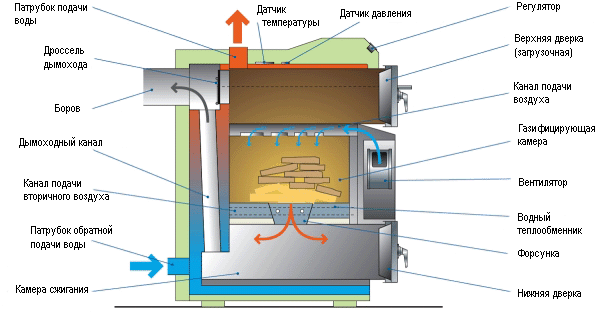
Schematic diagram of a pyrolysis boiler
The main operational and technical properties of the heating boiler depend on the type of fuel used. They have a direct impact on the durability, reliability and performance of the device. These same properties determine the ease of control of the heating system and the ease of its operation.
The complexity of installing an individual heating system also largely depends on the characteristics of the boiler. You need to study the features of existing equipment and choose the system that best suits your specific case.
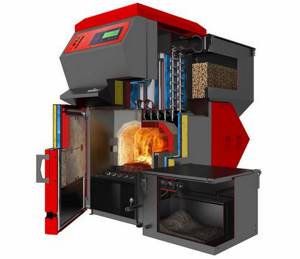
Combined heating boilers
Types of materials for making radiators
replace the heating system in the apartment, select heating radiators for the apartment
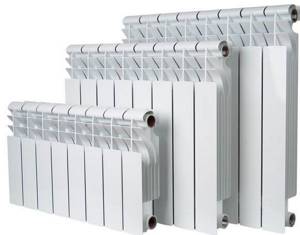
- Radiators made of cast iron
. The biggest advantage of cast iron is its low cost; moreover, it is highly durable, which will increase its service life for many decades. The features of this design are designed for the purchase of radiators with a large number of sections in order to heat the room quickly and efficiently. - Batteries made of steel
. Such structures are characterized by a high level of heat transfer, and are also able to withstand high loads and corrosion; moreover, they are easy to install indoors and ensure the most efficient operation. - Bimetal batteries
. This type is considered the most innovative and modern, in addition, they are light in weight and have a pleasant appearance. Such a heating system can be installed independently and without the help of specialists, and the combination of two types of metals increases resistance to external and internal influences and ensures maximum heat transfer (read: “The best heating radiators for an apartment: classification”).
System arrangement
When arranging water heating in a private house with your own hands, it is important to purchase several mechanisms and components. Among them are pipes. When choosing these designs, preference should be given only to plastic products, taking into account their temperature limit. It should be noted that pipes for both cold and hot liquids are available in the market.
The diameter of the pipes is determined only after a complete calculation of the system. However, it should not be less than 40 millimeters. According to experts, the best indicators are 20-25 mm.
The most reliable heating system:
When choosing radiators for heating boilers, you should use:
- Batteries made of cast iron.
- Steel.
- Aluminum.
- Bimetallic.
Each variety has its own strengths and weaknesses. For example, if cast iron structures heat up for a very long time, they are able to retain thermal energy for a long period of time. Aluminum models warm up faster than the previous type, but are afraid of corrosive effects and become deformed over time. The best solution on the modern market is bimetallic or steel batteries. Experts often call them the “golden mean”.
When arranging batteries, it is important to correctly calculate the optimal number of sections, because it determines the volume of thermal energy that will flow inside the room. It is not difficult to carry out such a calculation. To do this, it is necessary to clarify the exact area of the building, the average thermal potential of one section, and also take into account the ratio of the area of the room and the heat transfer from the radiators. The latter is the range of 60-200 W, taking into account climatic conditions.
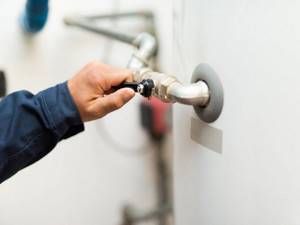
You need to choose radiators carefully; some of them may poorly conduct water flow
For a room of 20 square meters, the heat output value of one battery section is 170 W, and the ratio is 100 W. Such indicators can be found in SNiPs. All that remains is to perform a simple mathematical calculation using the formula:
- 20 × 100 = 2000 W of heat - the total amount of energy to heat the room.
- 2000 / 170 = 11.76 units.
In simple words, for a room of 20 square meters, a radiator battery with 12 sections is suitable. Naturally, such a calculation is approximate, because it does not imply taking into account the height of the ceiling and the type of batteries used.
Stages of connecting central gas heating
- The first thing you do is buy a boiler and gas stove. Since during design you will be asked for the equipment model.
- You order and pay for a gas heating project from the city gas service. Wait for it to be approved.
- After approval, you will equip the premises. Install ventilation, boiler and heating system.
- The gas service is installing pipes. He brings them to the house and installs the meter.
- The gas service supervisor and fire inspector check the work performed to ensure compliance with all requirements.
- You enter into an agreement with the gas service to service the boiler and stove.
- The gas is being started.
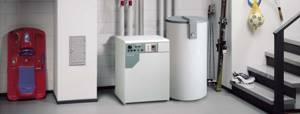
Frequent errors and problems
The most common errors in the installation of heating systems are:
- non-compliance with the project;
- lack of Mayevsky cranes. Air enters the system due to poor operation of the pumps in the boiler room, and comes out dissolved in water - it needs to be bled off periodically;
- when pouring a heated floor with a screed, the system’s tightness is not checked;
- they filled the floor heating system with screed without filling it with water - as a result, the screed cracked;
- Poor soldering and welding of pipes can lead to leakage.
Dismantling old pipes and risers
Emergency replacement of heating risers is the most unpleasant and difficult case. According to the law, repairs must be carried out by the management company, but if this is your personal desire, you will need to comply with some rules.
If you are going to change the riser and the entire system inside the apartment. You will need permission from your neighbors, and you must notify them and the utility company about the upcoming repairs. In cases where the waste structure is changed from a valve indoors, no permit is required. Dismantling the old system is carried out in the following sequence:
- Liquid is drained from all pipes and batteries and the water supply is shut off;
- If the pipeline is made of metal, you will need a grinder, which is used to cut off old products. When the riser is replaced on all floors, it must be cut so that the structure does not crack and is easy to remove;
- Old radiators are disconnected from the pipeline using wrenches.
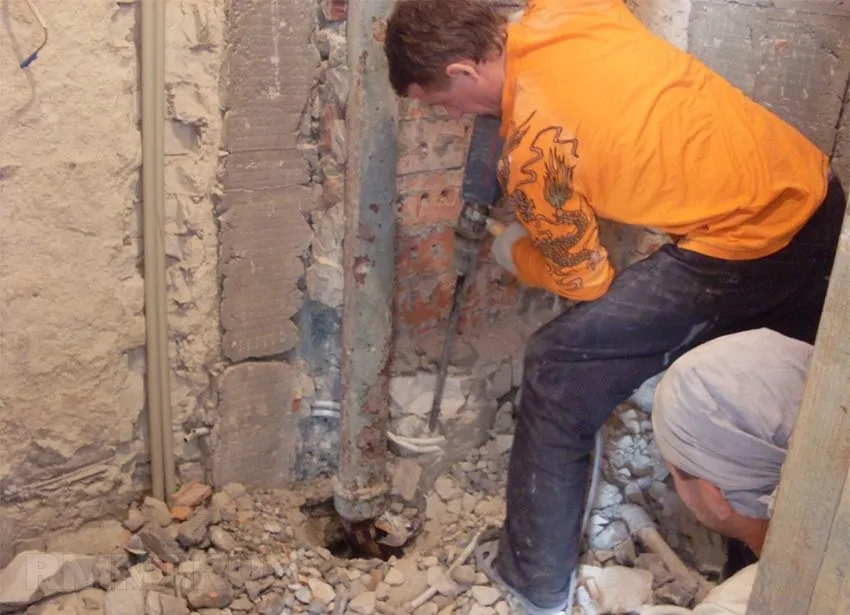
These steps will help remove unnecessary elements and allow you to proceed with the installation of a new system.
